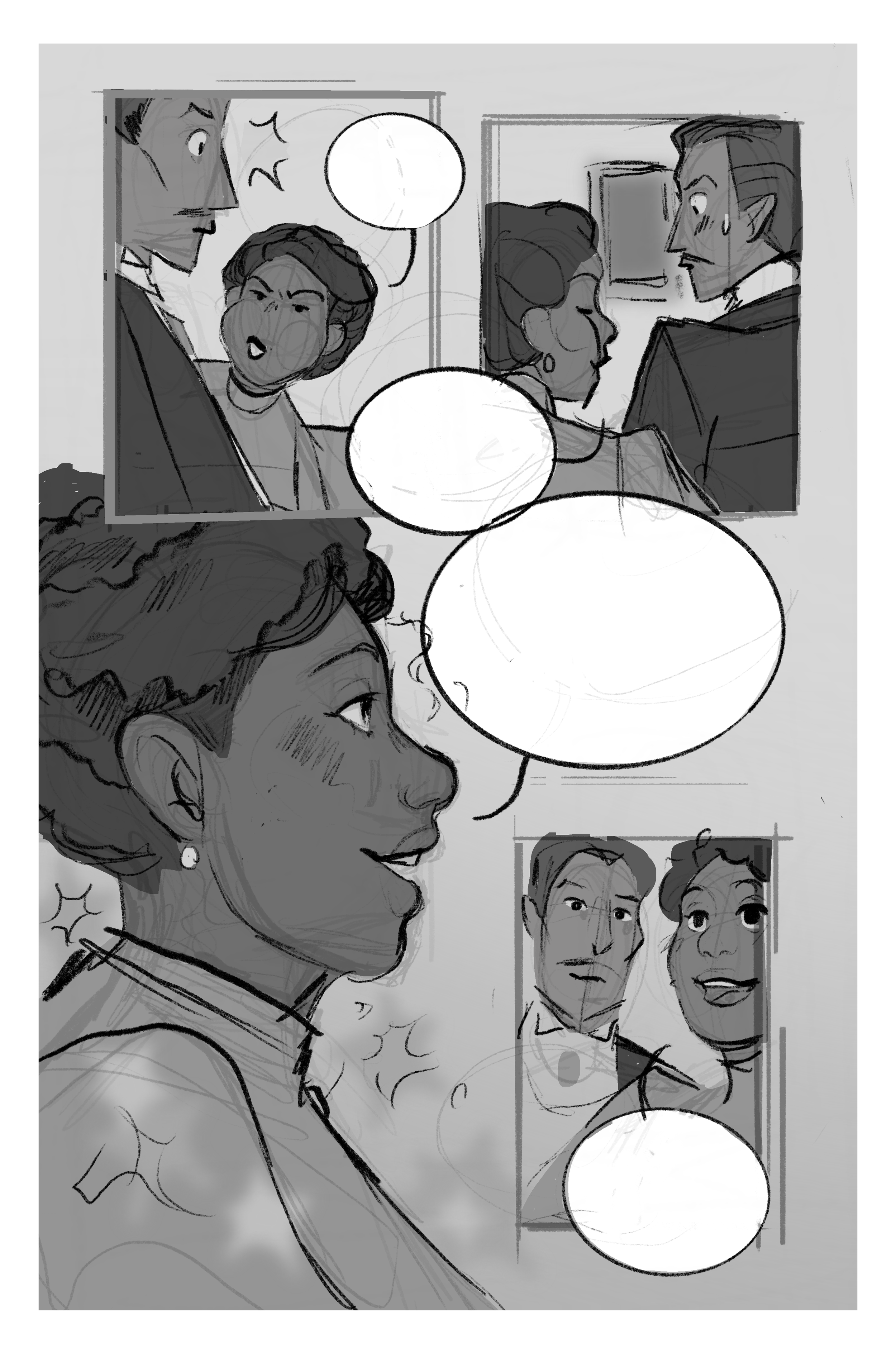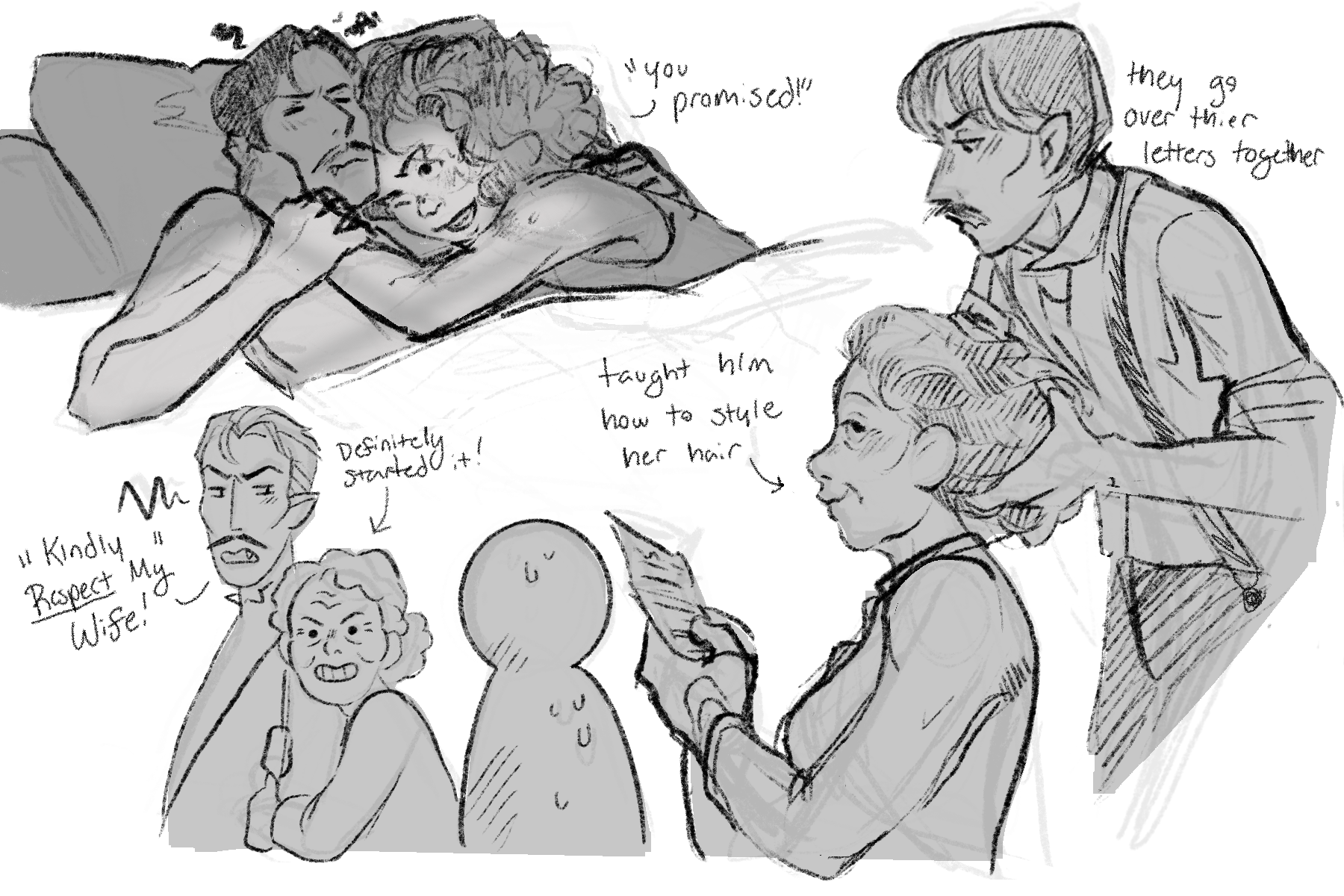That Old Romance
Synopsis:
In the turn of the 20th century, a vampire attends an art museum with his lover where they stop in front of a painting of a woman looking resolutely out of the canvas. She comments how much she loves that painting but the vampire scoffs and claims it has very little to offer. At his lover’s disapproval he tries to backtrack saying that the subject is not nearly as beautiful as her. His lover rebukes him, saying that the subject is beautiful because of the way she looks straight at the artist painting her without shame. The lover admires the subject’s look of fearlessness. The lover confides that they can only hope to have that much courage in the years to come. The vampire ask what they could possibly have to fear with him around. The lover laughs and scolds him for being such an old romantic. Turning serious, the lover skates over that though they take their relationship day by day, there may come a time when the gulf is too big for them to continue on. She remarks that in a way, the subject may outlive them both. The vampire is quiet until the Lover shakes him out of his mood, by chiding him for being so old and still not understanding art, and they walk away from the painting.
Sixty years later, the Vampire stands before the painting again, alone. That night, he breaks in easily and lifts the painting from the walls, skirting the guards. He leaps through the city and finally slips through the open window of a hospital. His lover in the hospital bed smiles and scolds him for being such an old romantic.
(16 pages, full color, The flash forward will take place in the 60’s so there’s a little element of old heist movie felt. Also bumbling security guard action.)
Vampire and their Lover Character Concepts
The Discussion Concept
First Scene Concept
Character Concepts
Vamp on the Run
A Study in Form of the Chalkhill Blue (title subject to change)
Synopsis:
In March of 1820’s at a society party, young naturalist, Henry Allen Stippling, is introduced to Beatrice Margaret Clark, by his great-aunt. Beatrice is a bright young woman who has an avid interest in the field of entomology and a bad habit of chewing their thumbnail. Although already half-way smitten with them, Stippling is shocked when they introduce themself as the wife of Jules Emerson Clark, a reclusive author of several papers on butterflies and beetles and fellow member of the royal society. While Stippling admires the man’s insight, he is put off by his odd and aloof manner and even notices that Clark isn’t present at the party to accompany his wife. Beatrice gives a halfhearted excuse for their husband, but distracts Stippling by engaging him in lively debate over the feeding of specimen.
While discussing their collections, Stippling is overcome with excitement at finding such a knowledgeable conversation partner and invites Beatrice to his latest expedition in Wales in May to study the populations and attain a couple of local specimen. His great-aunt is aghast that he would suggest such a thing to a “woman of good breeding” and berates him before Beatrice interrupts them to turn him down. While they are flattered, they will actually be returning to the country for their health at the request of their family doctor. This will probably be their last party of the season. Stippling is heart-broken but delights when Beatrice asks for his permission to write to him. When Beatrice walks away, his great-aunt remarks that she was lucky to marry considering how tall she is.
Thus Stippling and Beatrice begin a constant correspondence about the subject of butterflies. One day Jules is the one to deliver the letter while Stippling is in the naturalist gentlemen’s club. Stippling still finds him cold but is too eager to read his letter to give him much notice, though the reader will note the fact that Jules also possesses a bitten fingernail on his thumb. Beatrice meanwhile bemoans the fact that their health seems to be on the decline, Stippling promises to visit them with a new specimen as a gift.
While on his Welsh trip however, Stippling is horrified when he gets a letter from his great-aunt that Beatrice has suddenly passed. Stippling cuts his trip short and sends word that he will visit Jules to give his condolences. Jules answers the door and Stippling produces his belated gift for Beatrice, a live Chalkhill Blue. Jules smiles and leads Stippling to the greenhouse packed with butterflies. Stippling is in awe and Jules claims that it was Beatrice’s pride and joy. Stippling, distracted, proclaims that losing Beatrice was a loss for the world of science. Jules regards him and asks if he would have pushed for Beatrice to join the Royal Society. Stippling, embarrassed, admits that though women are not allowed he would have staked his own membership on their admittance. Jules laughs and says, had Beatrice known his sentiments, they would have tried to hold on a bit longer. Jules invites Stippling to stay for tea but Stippling is flustered by the sudden show of mirth by Jules (and how attractive he is when he does smile) excuses himself. Jules does not see him out but says that he is welcome back anytime.
When the tea arrives Jules removes his beard and mustache, remarking that he doesn’t like sipping the tea through a strainer, revealing that there was never any Jules, only Beatrice.
(20 pages, full color. While the crime is a quiet one, I wanted a story paying tribute to the scientists who were stonewalled based purely on their identity.)
The Butterfly Room Concept Page
Beatrice/Jules Character Sheet
Great Aunt
Gynandromorphic Butterfly
Stippling doing Field Work
The Quiet Hours
Synopsis:
The house is silent as a mouse sneaks in through a hole in the wall. Unrolling a map, the mouse makes their way through the darkened rooms, at one point having to hide behind a ceramic figure to escape notice of the prowling house cat. Finally arriving at their destination, the mouse scurries up the counters with a grappling “fish” hook to the cookie jar. Prying up the lid, the mouse pulls out two cookies which they strap to their back. They return to their cozy hole, where we see them enjoying a midnight snack by the glow of a tea light. We also see that the mouse has left the second cookie as a thank you offering to the ceramic figure that hid them.
(5 pages, black & white, think Beatrix Potter with a touch more noir lighting.)
Mouse and Grappling Hook Concept
Kitchen Entrance Concept
Prior Book Work
Ghost Roast is a graphic novel being published by Versify/Harper Collins (2024)
Cover for Ghost Roast (2024)
Pete Children’s Book (2022)
Pete Children’s Book (2022)















